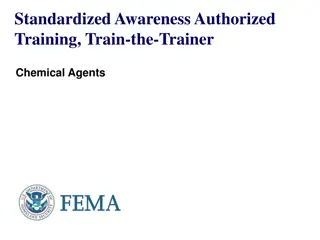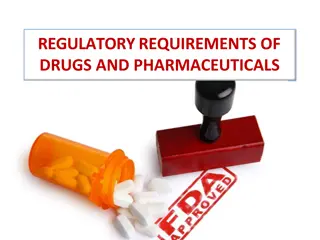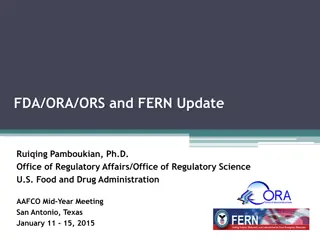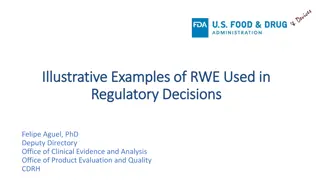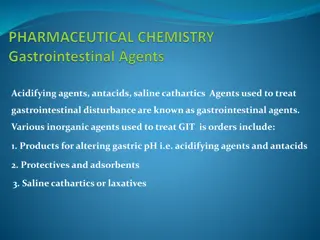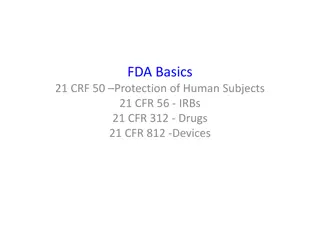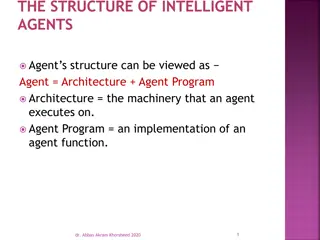FDA Oncology's Regulatory Perspective on Agents for CIPN
Supportive care plays a crucial role in cancer treatment as it helps in reducing symptoms and side effects of chemotherapy agents. Chemotherapy-induced peripheral neuropathy (CIPN) is a significant issue affecting a substantial percentage of patients, with symptoms that can lead to dosage adjustments or treatment interruptions. Despite the paucity of evidence for effective prevention or treatment options for CIPN, understanding the manifestations and scope of the problem is essential for optimizing patient care. FDA Oncology prioritizes the balance between supportive therapies and anti-cancer treatments while emphasizing the variability of chemotherapy agents causing CIPN and the importance of trial design and patient selection.
Download Presentation

Please find below an Image/Link to download the presentation.
The content on the website is provided AS IS for your information and personal use only. It may not be sold, licensed, or shared on other websites without obtaining consent from the author.If you encounter any issues during the download, it is possible that the publisher has removed the file from their server.
You are allowed to download the files provided on this website for personal or commercial use, subject to the condition that they are used lawfully. All files are the property of their respective owners.
The content on the website is provided AS IS for your information and personal use only. It may not be sold, licensed, or shared on other websites without obtaining consent from the author.
E N D
Presentation Transcript
Striking the Balance: FDA Oncology s Regulatory Perspective on Development of Agents for CIPN Lynn Howie, MD, Medical Officer, DOP1
Supportive Care is Crucial for Cancer Treatment Antiemetics Growth factors Bone health agents Agents to reduce mucositis Anti-diarrheals Supportive care therapies reduce symptoms and side effects allowing for improved delivery of chemotherapy agents, many of which are given with curative intent (e.g. adjuvant chemotherapy, stem cell transplant, and treatment of leukemia/lymphoma) 2
CIPN: Scope of the Problem Incidence: approximately 40% Variable based on anti-cancer agent and method of assessment Oxaliplatin, an agent widely used for treatment of CRC, may have an incidence as high as 90% Symptoms can lead to chemotherapy dose reductions, delays and/or early discontinuation Hershman, D. L., et al. (2014). "Prevention and management of chemotherapy-induced peripheral neuropathy in survivors of adult cancers: American Society of Clinical Oncology clinical practice guideline." J Clin Oncol 32(18): 1941-1967. 3 Attal, N., et al. (2009). "Thermal hyperalgesia as a marker of oxaliplatin neurotoxicity: a prospective quantified sensory assessment study." Pain 144(3): 245-252.
CIPN: Scope of the Problem Manifestations of CIPN: Pain, numbness Difficulty with proprioception/balance Motor symptoms Autonomic symptoms Chronic neuropathy can be detrimental to function and quality of life Hershman, D. L., et al. (2011). "Association between patient reported outcomes and quantitative sensory tests for measuring long-term neurotoxicity in breast cancer survivors treated with adjuvant paclitaxel chemotherapy." Breast Cancer Res Treat 125(3): 767-774. 4
Paucity of Evidence Multiple agents for prevention of CIPN have been studied, but none have been approved based on review of the clinical data provided to support the indication As a practicing physician, I have few evidence- based options for preventing or treating CIPN making this an unmet medical need 5
What is important to FDA Oncology? Evidence that supportive therapies do not attenuate or interfere with anti-cancer therapies Awareness of the variability of chemotherapy agents used that cause CIPN Trial design and patient selection 6
What is important to FDA Oncology? Different agents have different mechanisms of neurotoxicity Approval with one chemotherapy or chemotherapy regimen does not automatically mean approval for use with all chemotherapies/ chemotherapy regimens Development should be focused on agents that prevent and/or treat peripheral neuropathy for commonly used chemotherapies in common malignancies 7
Agents Associated with CIPN Class Examples Diseases Treated Microtubule inhibitors (taxanes, eribulin) Paclitaxel, docetaxel, eribulin Breast, ovarian, uterine, gastric, lung, head and neck (H&N), esophageal cancer, sarcoma Platinum agents Cisplatin, carboplatin, oxaliplatin Ovarian, uterine, H&N, gastric, lung, esophageal, testicular, bladder, colorectal cancers Proteasome inhibitors Bortezomib, carfilzomib Multiple myeloma, mantle cell lymphoma Vinca alkaloids vincristine, vinorelbine, vinblastine Lymphoma, breast cancer, acute lymphocytic leukemia (ALL) Immunomodulators Ipilimumab, pembrolizumab, nivolumab, atezolizumab Melanoma, lymphoma, lung, H&N, bladder cancer 8
Chemotherapy and Neurotoxicity Symptoms Drug Manifestations of CIPN Possible Mechanism of Action Thought to be interaction with sodium (Na+) gated voltage channels Oxaliplatin Acute neurosensory neuropathy associated with cold (transient) Cumulative Sensory Polyneuropathy (chronic) Sensory loss and ataxia Cisplatin Peripheral neuropathy Ototoxicity Tremor Loss of position sense Thought to be related to neuronal apoptosis related to mitochondrial dyusfunction Carboplatin Least incidence of platinum agents most dose dependent Peripheral neuropathy Thought to be related to neuronal apoptosis 9
Chemotherapy and Neurotoxicity Symptoms Drug Manifestations of CIPN Possible Mechanism of Action Microtubule inhibition Possibly the Cremophor-ethanol drug vehicle Paclitaxel Acute neuropathy manifested as pain syndrome with myalgias and arthralgias dose dependent Chronic neuropathy characterized by numbness/tingling rather than pain Docetaxel Generally less neurotoxic than paclitaxel Generally parasthesias, numbness or pain in hands/feet Microtubule inhibition 10
Risk Factors for Development of CIPN Age 65 Diabetes mellitus Prior Chemotherapy Obesity Smoking history Vitamin deficiencies Decreased creatinine clearance 11
Pre-clinical Drug Development Preclinical evidence the drug does not interfere with anti-tumor activity of chemotherapy: Data characterizing the mechanism of action of the drug and a scientific rationale which supports the postulate there is no interference with the mechanism of action of the investigation product and the chemotherapy agents used Pharmacology studies with the investigational agent in combination with chemotherapy (e.g., in vitro proliferation, murine xenograft models) demonstrating no impairment of chemotherapy-related antitumor activity 12
Clinical Studies Initial trials must be performed in patients with metastatic disease as the outcome on tumor related endpoints (i.e. survival, PFS) is unknown Important to consider comorbidities with increased risk of neuropathy in the trial design Well-designed, randomized, placebo controlled trials with a homogeneous patient population (same tumor type, same stage of disease, same treatment) and with appropriate endpoints Symptom assessment and severity Objective measure(s) of functional loss More than one trial necessary to confirm safety and efficacy 13
Clinical Studies: Additional Caveats Efficacy: Symptom and functional assessment are required Seek early advice from FDA Clinical Outcomes Assessment group regarding appropriate measures Safety: Evaluation of adverse events (CTCAE) and demonstration there is no decrement in tumor- related outcomes (i.e. overall survival, PFS) Balance of safety and efficacy is key for successful development 14
Symptom-Measurement Scales The symptom(s) which are selected for study must be validated using the chemotherapy regimen in the disease studied Focus group(s) of patients (same disease and stage, same chemotherapy) to determine the most bothersome symptoms Testing symptom assessment in a new larger group (same disease, same chemotherapy) Demonstrate that symptoms selected occur at a frequency that allows study Demonstrate that scales used detect the severity of the symptoms can be validated statistically 15
Functional Evaluation Objective measure of the impact on the functional impairment Measure(s) have to be sensitive enough to detect differences between arms Functional assessment must be validated Challenge is to develop a group of functional assessments that can be used in clinical trials with different chemotherapies or across different classes of chemotherapy drugs 16
Trial Design: Other Considerations Trial duration Long enough to detect the onset, the progression, and the possible improvement in the chronic neuropathy Long enough to ensure adequate information about tumor-related endpoints (i.e. safety) is available Functional and symptom assessments should be validated in cancer population Given lack of clarity of relationship between acute neuropathic syndromes and chronic syndromes, targeting acute neuropathic syndromes is not clear surrogate for clinical benefit 17
Non-Drug Modalities Neurofeedback Scrambler Device We encourage early work with the Center for Devices and Radiologic Health (CDRH) for the development of devices for CIPN Neurofeedback: (Das 2017); Scrambler: http://nationalpainreport.com/scrambler-therapy-%E2%88%92-a-new-way-to-treat-chronic- pain-without-drugs-or-invasive-devices-8827467.html 18
Take Home Messages Evidence agents do not attenuate anti-cancer therapy and do not negatively effect tumor- related outcomes Safety Same underlying malignancy Same anti-cancer therapy Minimize patients with comorbidities with risk Population Measure symptoms Measure change in function Endpoints 19
Acknowledgements ACTTION Jennifer Gewandter, PhD Roy Freeman, MD FDA OCE PFDD Paul Kluetz, MD FDA COA Selena Daniels, PharmD Elektra Papadopoulos, MD, MPH FDA DOP 1 Geoffrey Kim, MD Laleh Amiri-Kordestani, MD Julia Beaver, MD Genevieve Schechter, MD Todd Palmby, PhD 20



